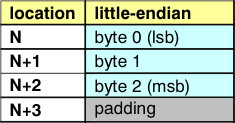SLAA534A June 2013 – June 2020
- 1 Introduction
- 2 Data Representation
-
3 Calling Conventions
- 3.1 Call and Return
- 3.2 Register Conventions
- 3.3 Argument Passing
- 3.4 Return Values
- 3.5 Structures and Unions Passed and Returned by Reference
- 3.6 Conventions for Compiler Helper Functions
- 3.7 Scratch Registers for Functions Already Seen
- 3.8 _ _mspabi_func_epilog Helper Functions
- 3.9 Interrupt Functions
- 4 Data Allocation and Addressing
- 5 Code Allocation and Addressing
- 6 Helper Function API
-
7 Standard C Library API
- 7.1 Reserved Symbols
- 7.2 <assert.h> Implementation
- 7.3 <complex.h> Implementation
- 7.4 <ctype.h> Implementation
- 7.5 <errno.h> Implementation
- 7.6 <float.h> Implementation
- 7.7 <inttypes.h> Implementation
- 7.8 <iso646.h> Implementation
- 7.9 <limits.h> Implementation
- 7.10 <locale.h> Implementation
- 7.11 <math.h> Implementation
- 7.12 <setjmp.h> Implementation
- 7.13 <signal.h> Implementation
- 7.14 <stdarg.h> Implementation
- 7.15 <stdbool.h> Implementation
- 7.16 <stddef.h> Implementation
- 7.17 <stdint.h> Implementation
- 7.18 <stdio.h> Implementation
- 7.19 <stdlib.h> Implementation
- 7.20 <string.h> Implementation
- 7.21 <tgmath.h> Implementation
- 7.22 <time.h> Implementation
- 7.23 <wchar.h> Implementation
- 7.24 <wctype.h> Implementation
-
8 C++ ABI
- 8.1 Limits (GC++ABI 1.2)
- 8.2 Export Template (GC++ABI 1.4.2)
- 8.3 Data Layout (GC++ABI Chapter 2)
- 8.4 Initialization Guard Variables (GC++ABI 2.8)
- 8.5 Constructor Return Value (GC++ABI 3.1.5)
- 8.6 One-Time Construction API (GC++ABI 3.3.2)
- 8.7 Controlling Object Construction Order (GC++ ABI 3.3.4)
- 8.8 Demangler API (GC++ABI 3.4)
- 8.9 Static Data (GC++ ABI 5.2.2)
- 8.10 Virtual Tables and the Key function (GC++ABI 5.2.3)
- 8.11 Unwind Table Location (GC++ABI 5.3)
-
9 Exception Handling
- 9.1 Overview
- 9.2 PREL31 Encoding
- 9.3 The Exception Index Table (EXIDX)
- 9.4 The Exception Handling Instruction Table (EXTAB)
- 9.5 Unwinding Instructions
- 9.6 Descriptors
- 9.7 Special Sections
- 9.8 Interaction With Non-C++ Code
- 9.9 Interaction With System Features
- 9.10 Assembly Language Operators in the TI Toolchain
- 10DWARF
- 11ELF Object Files (Processor Supplement)
- 12ELF Program Loading and Linking (Processor Supplement)
- 13Build Attributes
- 14Copy Tables and Variable Initialization
- 15Revision History
2.3 Data in Memory
The MSP430 uses little-endian mode only. Endianness refers to the memory layout of multi-byte values. In little endian mode, the least significant byte is stored at the smallest address. Endianness affects only objects' memory representation; scalar values in registers always have the same representation regardless of endianness. Endianness does affect the layout of structures and bit fields, which carries over into their register representation.
Scalar variables are aligned such that they can be loaded and stored using the native instructions appropriate for their type: MOV.B for bytes, MOV.W for words, and MOVA for 20-bit addresses. These instructions correctly account for endianness when moving to and from memory.
Twenty-bit addresses have 3 bytes, designated 0 (LSB) through 2 (MSB). In memory, 20-bit values are padded to 32 bits (4 bytes). If the address of the value in memory is N, then Figure 2-1 gives the storage layout:
 Figure 2-1 Representation of 20-Bit Values in Memory
Figure 2-1 Representation of 20-Bit Values in Memory